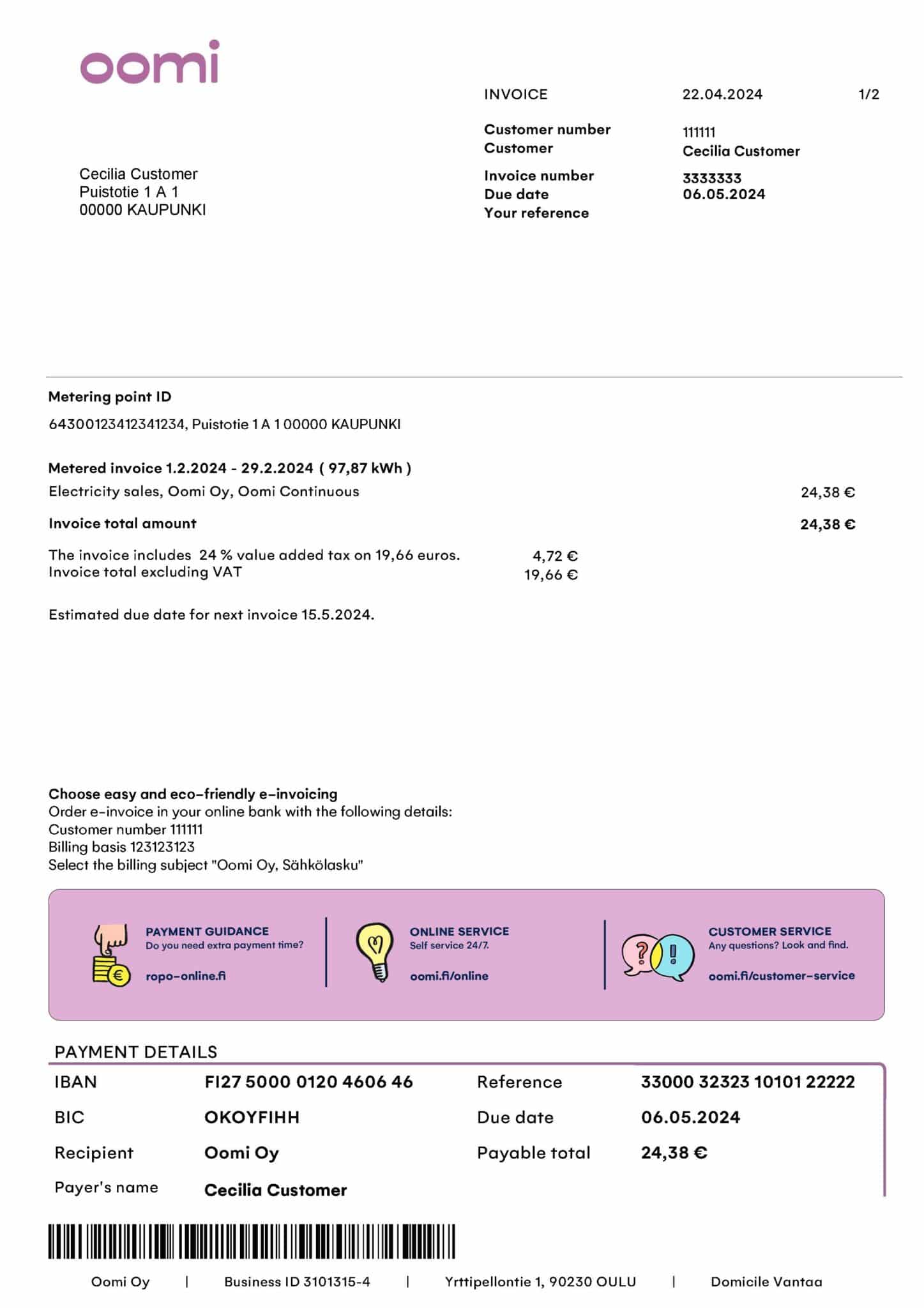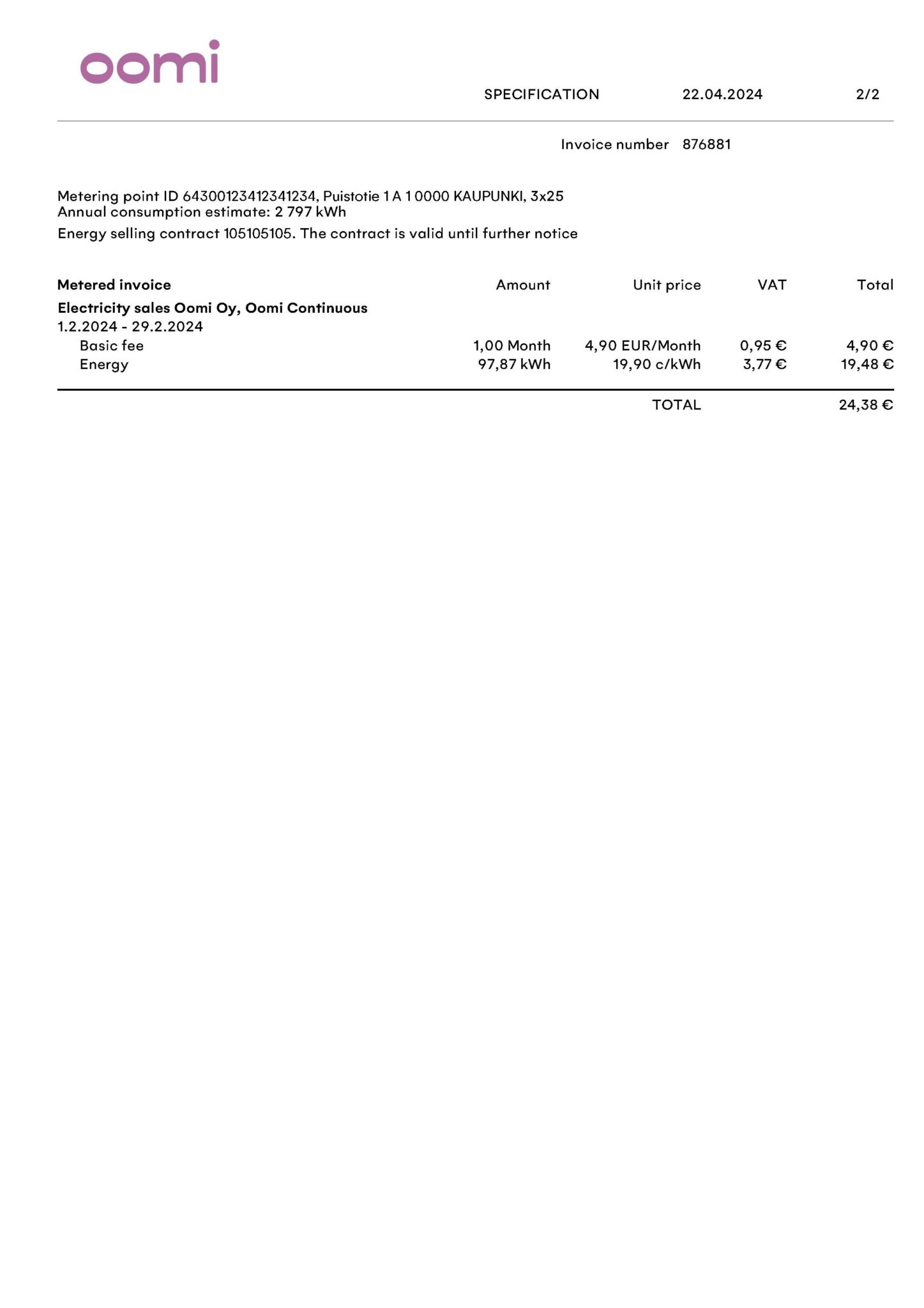How to read your electricity invoice
This text sheds light on the anatomy of the electricity invoice.
The total price of electricity is made up of three aspects: electrical energy, electricity distribution and taxes. You can choose the provider of your electrical energy yourself. The electricity distribution is always handled by the local network company, and the electricity tax is collected in connection with the distribution price. This means that you may receive two monthly invoices related to electricity: the local network company sends invoices for electricity distribution and the electricity vendor, such as Oomi, sends it own invoice for the electricity sold.
We can invoice you electronically, on paper or by e-mail.
The first page of the invoice lists all of the information required to pay the invoice. The second page lists the basic information of your contract and a more detailed specification of your consumption.
The electricity invoice section by section
(1) Customer and invoice information
We invoice for electricity consumption mainly on a monthly basis. The term of payment is 14 days from the date of the invoice. The top section of the invoice lists your customer number, which you should indicate when contacting our customer service team.
(2-3) Metering point and invoice summary
The metering point indicates the address to which the invoice for electricity consumption pertains.
The summary indicates the time period, service provider and contract type. The final sum of the invoice includes the price of electrical energy and value-added tax. If the invoice also covers the electricity distribution, the summary indicates the electricity distribution details on a separate row. A more detailed specification is provided on the second page of the invoice.
(4) The due date of the next invoice
Each invoice lists the estimated due date of the next invoice. If you need more time to pay any invoice or have any questions about invoice payment or collection, please contact our payment helpline. The centralised payment helpline is managed by Robo Capital Oy.
(5) Choose e-invoicing – it’s easy and convenient
You can sign an e-invoice contract in your online bank with this information. E-invoicing is a safe, fast and environmentally friendly way to pay your invoices. The only difference between an e-invoice and a paper invoice is the delivery method.
(6) Invoice payment details
If you have entered into an e-invoice subscription, your invoices are delivered directly to your online banking service. The reference number, account number and other invoice details are automatically filled in on the e-invoice and do not need to be typed in separately.
When paying a paper invoice, the easiest way is to use the barcode reader of you bank’s mobile app. If you prefer to receive your invoices by e-mail, you can use the virtual barcode for payment.
If you have any questions or comments on the invoice content, please contact the Oomi customer service team before the due date.







(7) Information about the electricity contract
The start of the invoice specification lists information about your electricity contract. The details indicate whether your contract is valid until further notice or for a fixed term and list the end date if you have a fixed-term contract.
(8) Invoice specification
An electricity invoice is based on invoicing according to consumption. This means that we always charge you according to your electricity consumption. The price of electricity is listed as cents per kilowatt-hour (c/kWh). Kilowatt-hour is a unit for measuring electricity consumption.
The invoice specification indicates the basic fee (€/month), amount of energy consumed (kWh), unit prices (c/kWh) and their sums. If the invoice also covers the electricity distribution alongside the electricity consumed, the specification also lists the sums related to it and the relevant electricity tax.
Exchange electricity customer: listing of the compensation for negative exchange electricity hours on the invoice
Since Oomi procures and sells electricity at the spot price, our invoices take into account the negative exchange electricity hours of customers with contracts that are based on exchange electricity and consumption impacts. This is not indicated on a separate invoice row. Instead, it affects the average spot price for the entire month. The price is listed in the c/kWh section as an average price calculated based on consumption and the hourly rate. The average price is determined by calculating the compensation for negative hours and the cost of positive hours to arrive at the net price, i.e. the monthly average spot price.
You can view your previous electricity invoices through our Online service.
Do you have further questions?
You can always contact us by telephone or message. Let’s find answers to your questions together.
- More information about invoicing
- Customer service




